Electric Scooters and Their Impact on Public Transportation

The Rise of Electric Scooters
In recent years, escooters have surged in popularity worldwide. Cities like Paris, San Francisco, and Berlin have embraced shared scooter programs, allowing riders to rent scooters via apps and quickly travel short distances. These lightweight vehicles provide flexibility, affordability, and ease of use, making them particularly appealing to commuters looking for “last-mile” transportation solutions. And for short-distance commuting and commuting in inconvenient places, electric scooters are also the best travel solution. Speed, flexibility, and convenience have always been synonymous with electric scooters.
Environmental Impact and Sustainability
One of the main advantages of escooters is their minimal environmental footprint. Powered by rechargeable batteries, these scooters emit no direct greenhouse gases, helping reduce urban air pollution. Compared to buses or cars, electric scooters use significantly less energy, making them a sustainable option for urban transportation. As cities look for ways to meet ambitious climate goals, incorporating escooters into transportation networks is a positive step toward reducing carbon emissions. By encouraging escooter usage, cities can also decrease the reliance on fossil fuels and cut down on noise pollution, making urban environments cleaner and quieter.
Enhancing Public Transit Systems
Electric scooters complement existing public transportation networks by addressing the “first-mile” and “last-mile” problem. For many commuters, public transit stations are too far to walk, but too close for a car or bus ride. Escooters offer a practical solution for short trips to and from transit hubs, reducing dependence on private vehicles while boosting public transport usage. In cities with congested roads and limited parking, escooters are a faster and more convenient way to navigate traffic-heavy areas. Riders can avoid delays caused by crowded buses or subway systems, making commutes more efficient and less stressful. With fewer cars on the road, escooters also help ease traffic congestion and improve overall traffic flow.
Challenges and Regulations
Despite their many benefits, the widespread use of electric scooters presents challenges. Safety concerns are one of the most pressing issues. Escooter accidents have raised questions about rider safety and the need for protective gear, especially in areas with high pedestrian traffic. Moreover, scooters left on sidewalks or roadways can obstruct public spaces, leading to calls for stricter regulations on scooter parking and usage. Cities worldwide are grappling with how best to integrate electric scooters into existing transport networks while ensuring safety and accessibility for all residents. Regulatory frameworks are emerging, with many municipalities implementing speed limits, designated parking zones, and helmet requirements to minimize risks.
A Shift Toward Micro-Mobility
The rise of escooters reflects a broader shift toward micro-mobility solutions, which include bicycles, electric bikes, and shared scooters. These modes of transportation are designed to tackle short-distance travel while reducing the environmental impact of traditional vehicles. As urban populations grow, micro-mobility options will play an increasingly important role in addressing the challenges of transportation infrastructure, urban sprawl, and pollution.
The Future of Public Transportation
As electric scooters continue to gain traction, their integration into public transportation systems is likely to expand. Cities may increasingly develop dedicated scooter lanes, improve scooter-sharing programs, and promote policies that encourage sustainable mobility. With advancements in battery technology, future escooters may offer longer ranges and better performance, further cementing their role as a key element of urban transportation. Ultimately, electric scooters represent a step toward more flexible, sustainable, and efficient transportation networks. As cities continue to adapt to the evolving needs of their residents, escooters will likely remain a vital part of the solution, helping to create smarter, more livable urban environments.
Conclusion
Electric scooters have made a significant impact on public transportation by offering a convenient, eco-friendly alternative to traditional methods of commuting. As they become more widely adopted, they hold the potential to reshape urban transit, reduce traffic congestion, and help cities meet their sustainability goals. By addressing last-mile connectivity and encouraging a shift toward micro-mobility, e-scooters are revolutionizing how people navigate their cities, paving the way for a cleaner, more efficient future of transportation.
